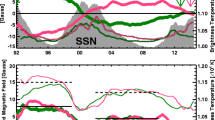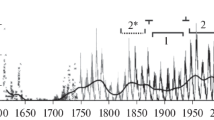Abstract
The solar eclipse on 1 August 2008 was studied on Svalbard (93% totality), an archipelago in the High Arctic, where midnight sun had been present for several months. Simultaneous observations over land and over a large fjord showed that the eclipse triggered downslope winds in the valleys surrounding the fjord, thereby creating low-level clouds over the water. These clouds were later advected in over land and created a fog that lasted for 3 days, grounding all air traffic to and from Svalbard. The atmospheric response was otherwise much slower and weaker over water than over land. Over land, the wind speed decreased, the atmospheric stability changed from unstable to stable and the air temperature sank by 0.3–1.5°C, while over the fjord no clear minima in these parameters could be found.









Similar content being viewed by others
References
Amiridis V, Melas D, Balis DS, Papayannis A, Founda D, Katragkou E, Giannakaki E, Mamouri RE, Gerasopoulos E, Zerefos C (2007) Aerosol Lidar observations and model calculations of the planetary boundary layer evolution over Greece, during the March 2006 total solar eclipse. Atmos Chem Phys 7:6181–6189
Anderson J (1999) Meteorological changes during a solar eclipse. Weather 54:207–215
Anderson RC, Keefer DR, Myers OE (1972) Atmospheric pressure and temperature changes during the 7 March 1970 solar eclipse. J Atmos Sci 29:583–587
Anfossi D, Schayes G, Degrazia G, Goulart A (2004) Atmospheric turbulence decay during the solar total eclipse of 11 August 1999. Bound Layer Meteorol 111:301–311
Antonia RA, Chambers AJ, Phong-Anant D, Rajagopalan S, Sreenivasan KR (1979) Response of atmospheric surface layer turbulence to a partial solar eclipse. J Geophys Res 84:1689–1692
Dolas PM, Ramchandran R, Gupta KS, Patil SM, Jadhav PN (2002) Atmospheric surface-layer processes during the total solar eclipse of 11 August 1999. Bound Layer Meteorol 104:445–461
Eaton FD, Hines JR, Hatch WH, Cionco RM, Byers J, Garvey D, Miller DR (1997) Solar eclipse effects observed in the planetary boundary layer over a desert. Bound Layer Meteorol 83:331–346
Foken T, Wichura B, Klemm O, Gerchau J, Winterhalter M, Weidinger T (2001) Micrometeorological measurements during the total solar eclipse of August 11, 1999. Meteorol Z 10:171–178
Founda D, Melas D, Lykoudis S, Lisaridis I, Gerasopoulos E, Kouvarakis G, Petrakis M, Zerefos C (2007) The effect of the total solar eclipse of 29 March 2006 on meteorological variables in Greece. Atmos Chem Phys 7:5543–5553
Girard-Ardhuin F, Bénech B, Campistron B, Dessens J, Jacoby-Koaly S (2003) Remote sensing and surface observations of the response of the atmospheric boundary layer to a solar eclipse. Bound Layer Meteorol 106:93–115
Gorchakov GI, Kadygrov EN, Kortunova ZV, Isakov AA, Karpov AV, Kopeikin VM, Miller EA (2008) Eclipse effects in the atmospheric boundary layer. Izv Atmos Ocean Phys 44:100–106
Gross P, Hense A (1999) Effects of a total solar eclipse on the mesoscale atmospheric circulation over Europe—a model experiment. Meteorol Atm Phys 71:229–242
Hanna E (2000) Meteorological effects of the solar eclipse of 11 August 1999. Weather 55:430–446
Kilpeläinen T, Sjöblom A (2010) Momentum and sensible heat exchange in an ice-free Arctic fjord. Bound Layer Meteorol 134:109–130
Lee X, Massman W, Law B (2004) Handbook of micrometeorology, a guide for surface flux measurement and analysis. Kluwer, Dordrecht, 250 pp
Leeds-Harrison P, Youngs EG, Blackburn DWK (2000) Soil temperatures during the solar eclipse on 11 August 1999. Eur J Soil Sci 51:183–184
Mauder M, Desjardins RL, Oncley SP, MacPherson I (2007) Atmospheric response to a partial solar eclipse over a cotton field in central California. J Appl Meteorol 46:1792–1803
McPherson RA (1995) Oklahoma schools view the 10 May 1994 eclipse. In: Preprints of the 4th AMS symposium on education. American Meteorological Society, Boston, MA
Morecroft M, Oliver H, Stokes V, Morison J (2000) Sensing and mis-sensing the eclipse. Weather 55:174–176
Prenosil T (2000) The influence of the 11 August 1999 total solar eclipse on the weather over central Europe. Meteorol Z 9:351–359
Schotanus P, Nieuwstadt FTM, De Bruin HAR (1983) Temperature measurement with a sonic anemometer and its application to heat and moisture fluxes. Bound Layer Meteorol 26:81–93
Segal M, Turner RW, Prusa J, Bitzer RJ, Finley SV (1996) Solar eclipse effect on shelter air temperature. Bull Am Meteorol Soc 77:89–99
Sjöblom A, Smedman A (2002) The turbulent kinetic energy budget in the marine atmospheric surface layer. J Geophys Res 107(C10):3142
Stewart RB, Rouse WR (1974) Radiation and energy budgets at an Arctic site during the solar eclipse of July 10, 1972. Arct Alp Res 6:231–236
Szalowski K (2002) The effect of the solar eclipse on the air temperature near the ground. J Atmos Sol Terr Phys 64:1589–1600
Vogel B, Baldauf M, Fiedler F (2001) The influence of a solar eclipse on temperature and wind in the Upper-Rhine valley—a numerical case study. Meteorol Z 10:207–214
Winkler P, Kaminski U, Köhler U, Riedl J, Schroers H, Anwender D (2001) Development of meteorological parameters and total ozone during the total solar eclipse of August 11, 1999. Meteorol Z 10:193–199
Acknowledgments
Ms. Tiina Kilpeläinen and Dr. Lene Kristiansen are thanked for the help with instruments and data. The weather station at the Seed Vault is financed through CRYOSLOPE Svalbard (The Research Council of Norway, 176236/S30). Dr. Stephen J. Coulson is thanked for valuable comments on the manuscript, and the anonymous referees for their constructive criticism on the manuscript.
Author information
Authors and Affiliations
Corresponding author
Rights and permissions
About this article
Cite this article
Sjöblom, A. A solar eclipse seen from the High Arctic during the period of midnight sun: effects on the local meteorology. Meteorol Atmos Phys 107, 123–136 (2010). https://doi.org/10.1007/s00703-010-0070-3
Received:
Accepted:
Published:
Issue Date:
DOI: https://doi.org/10.1007/s00703-010-0070-3




